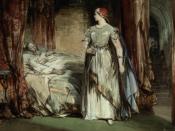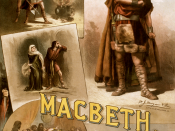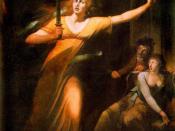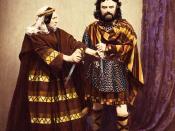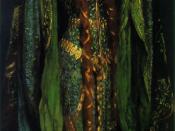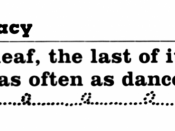Pathetic fallacy is an integral part of the atmosphere, in Macbeth. Pathetic fallacy is defined as the poetic practice of attributing human emotions or responses to nature, inanimate objects, or animals. Prior to the murder, Shakespeare uses pathetic fallacy to increase suspense, and allow the reader to better understand what is going on in the novel. Macbeth uses the weather, during DuncanÃÂs murder, to heighten the atmosphere. After DuncanÃÂs murder pathetic fallacy is used to demonstrate how terrible DuncanÃÂs murder is. The use of weather to develop the atmosphere, throughout Macbeth, increases tension and suspense in the novel.
Shakespeare uses the weather to reflect Lady MacbethÃÂs desire for strength in killing Duncan. She criesÃÂ Come, thick night, And pall thee in the dunnest smoke of hell, That my keen knife see not the wound it makes, Nor heaven peek through the blanket of the dark, To cry ÃÂHold, hold!ÃÂÃÂ (I, v, 50-54).
This section of the novel builds her character, and the atmosphere, with regards to her intent to kill Duncan. She attributes human responses and emotions to her knife, and the night. She refers to her knife as being keen and having sight. Lady Macbeth calls for darkness because she believes that the heinous act of killing Duncan must occur in darkness. This attribution of human qualities to inanimate objects and things helps to build the tension. The idea of pure darkness seems to reflect the importance of the act that is to be committed. The references to heaven and hell, comparing them with human words seems to reflect upon the character what is yet to come. It foreshadows future events in the play. Throughout the play Shakespeare continues with this theme ÃÂlook like the innocent flower, but be the serpent underÃÂtÃÂ (I, vi, 65-66). In this case Shakespeare uses animals to reflect the atmosphere of deceit and treachery. He refers to an innocent flower, which is often imagined as bright and beautiful, comparing it to a snake, which is thought of as vile and treacherous, attacking without warning. This idea of having two sides to contend with seems to foreshadow how complex Lady MacbethÃÂs feelings are regarding the murder. Later on in the play you see her become more questioning, and aware of how this night has affected her. It heightens the atmosphere because it seems to bring about the image of evil lurking behind others, and remaining hidden from those who will be its victims. Throughout the play you see references made to true emotions being hidden behind false faces. In this case the atmosphere becomes more stressed because Lady Macbeth is telling Macbeth to be kind and cordial to Duncan when he visits, but to remain evil at heart. This train of thought continues further to the end of Act 1, because you see how great a king Duncan has been, and how damning his death will be for his country. This entire section uses pathetic fallacy to show the reader what may come to pass in the future, and the reaction it will cause throughout all the kingdoms. Shakespeare uses the weather as a form of pathetic fallacy, to help foreshadow approaching crisis in the play Macbeth.
During DuncanÃÂs murder pathetic fallacy is used to build tension around MacbethÃÂs plot, and its chances of success. At the time of his murder Macbeth is ÃÂAlarumÃÂd by his sentinel, the wolf, Whose howlÃÂs his watchÃÂ (II, i, 53-54). Macbeth uses the wolf as howl to cause Macbeth to slip further into madness, becoming more fearful and afraid of his actions. Lady Macbeth refers to the animals and how DuncanÃÂs death has affected them, ÃÂI heard the owl scream and the cricket cryÃÂ (II, ii, 15). This builds on the idea that the entire animal kingdom has been affected by DuncanÃÂs death. It heightens the atmosphere because it causes Macbeth great inner turmoil, and demonstrates the climax of the play, with animals going wild, and the very earth shaking underneath Macbeth. In one part of the act it mentions how the stones underneath Macbeth begin to shakes, almost as though there is an earthquake. This heightens the atmosphere, and projects the image of the atmosphere and how tumultuous life has become. This idea of things being turns around ÃÂdark night strangles the traveling lamp: IsÃÂt nightÃÂs predominance or the dayÃÂs shameÃÂ (II, iv, 6-7). The idea is that all light has been drowned out by night, by the horrible act committed. It seems that night has taken over and day is to ashamed to face the evil act that was committed during the last night. This idea of darkness prevailing over light foreshadows what might happen to those who are innocent of evil deeds. Shakespeare uses pathetic fallacy to enhance the readerÃÂs understanding of DuncanÃÂs murder.
Shakespeare attributes human qualities to animals, in order to further improve the mood in the play. He describes the terror and horror of DuncanÃÂs death using the animal kingdom. ÃÂA falcon towering in her pride of place was by a mousing owl hawkÃÂd at, and killed.ÃÂ (II, iv, 12-13). He attributes this unnatural phenomena to the night closing in on the day. The falcon is normally considered a bird that flies around during daylight, whereas the mousing owl is considered an animal who flies at dark. This idea seems to heighten the facts of DuncanÃÂs murder, and how an innocent man was killed by an animal of the night.
work citedShakespeare, William. Hamlet. Ed. Barbara A. Mowat and Paul Werstine.
New York: St. Martin's, 1998.
